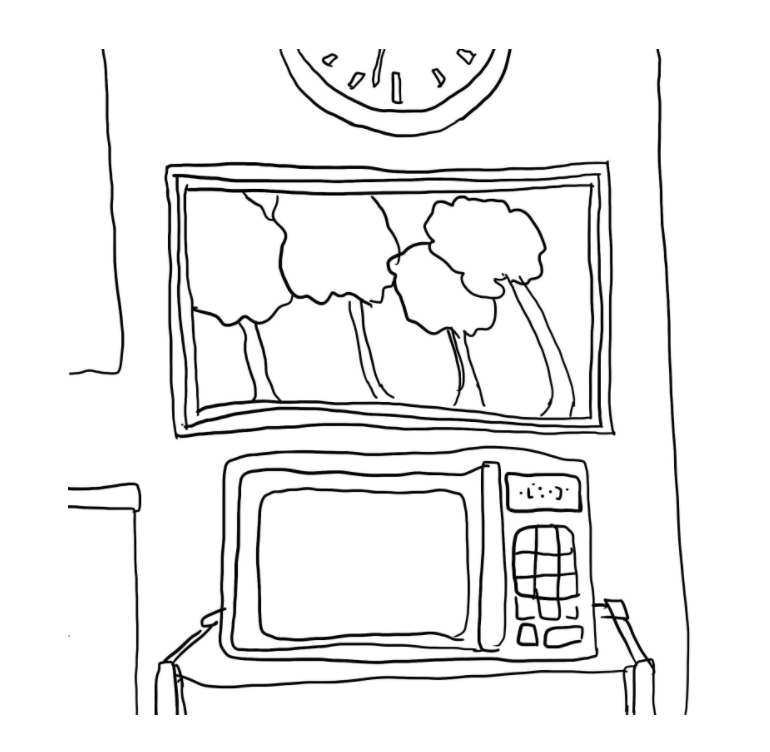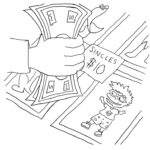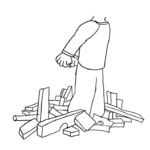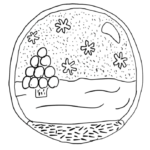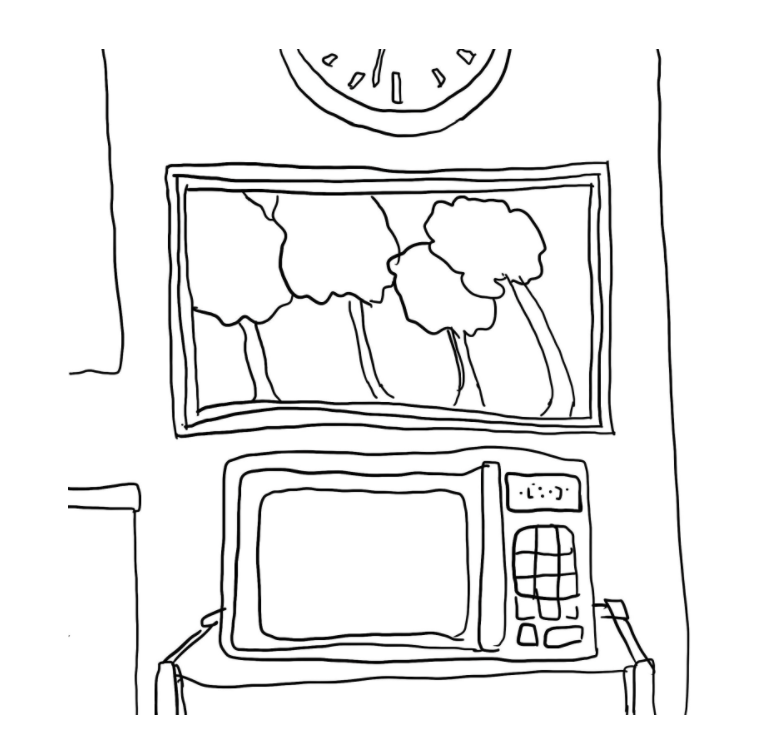
You know how when kids are very little, adults tell them that pretty much everything they do is amazing? They take one step, it’s amazing. They say one word, it’s amazing. They eat a piece of cheese, it’s amazing.
Then, once little kids start creating things, adults call their creations amazing, too:
Lego tower? Amazing.
Puppy drawing? Amazing. Hang it on the fridge.
Original song and dance? Amazing. Honey, get your phone, record this!
A special dessert you made all by yourself? Amazing! I can’t wait to taste it. Everyone grab a spoon (…and brace yourself).
Of course, you and I know that most of these childhood creations are not amazing. Most of them are pretty underwhelming, if not terrible. Just keeping it real. So all this praise can be pretty empty.
And yet, I’ve come to believe that such praise is very important. I think little children need to hear that their creations are amazing, over and over again, even when they’re not. Here’s how I came to believe that.
***
Ms. Mary had poofy blonde hair and was the nicest of my teachers. Maybe that’s why I chose to tell her my Peter Pan story. I don’t remember much about the plot; only that it was a sequel of sorts. I assume it was an action-packed tale, because I remember waving my arms around as I told it. I remember Ms. Mary’s face as she listened; her big smile and dancing eyes. Shortly after I began, she asked me to pause the story, just for a second. She grabbed some sheets of drawing paper and a green Crayola marker, then sat down in a small blue chair. She motioned for another teacher to join us.
“Andy was just telling me a story about Peter Pan,” she explained. “And it is so good, I wanted to write it down!”
“I can’t wait to hear,” said the second teacher.
“Go on, Andy,” said Ms. Mary.
I continued to tell my Peter Pan story. I waved my arms and watched their nodding heads and smiles. Ms. Mary wrote hurriedly in green Crayola.
It was incredible to have two teachers’ full attention. I watched Ms. Mary’s green marker catch my words from the air and transform them into letters on a page. When I was done, Ms. Mary capped the marker and looked back at the pages she had transcribed.
“Andy, what an incredible story. Look at how many pages I wrote!” She tapped the papers against the table, evening out their edges, then handed the stack over to me. “Make sure you show Mommy when she picks you up.”
I nodded, staring at the papers, green word upon green word. Though I could not yet read, I could tell I had done something worthy.
I kept telling stories. In a few years, I would begin to write them down myself.
***
I saw my father every other weekend. That was the arrangement, and when I was younger, we stuck to it.
My father was very different from my mother. Mom was warm and outwardly loving. She was a hugger. She told me constantly how much she loved me. Dad was not like that. He shook hands instead of hugging. He didn’t talk much. He was an awkward and restrained guy. Back then, this was pretty confusing for me. It was hard for me to understand why my Dad felt so different from my Mom. At times, I thought it meant that he loved me less.
When I grew up, I realized that that wasn’t true. I figured out that my Dad grew up at a time, and in a household, where men were supposed to act a certain way, which was pretty much the way he acted: strong, steady, and tough. Now, looking back, I can see better all the ways that my Dad showed his love for me, in his own style, and the best that he could. But when I was little, he seemed cold and distant, even when he was right there.
There were times, however, when Dad lightened up. My debut performance of the Peanut Butter Jelly Song, circa 1990, was one of those times.
I learned the Peanut Butter Jelly Song at school. You may be familiar with it. It’s a catchy tune that tells the listener how to build a PB and J sandwich. Goes something like this:
First you take the peanuts and you smoosh ’em, you smoosh ’em.
Then you take the grapes and you smash ’em, you smash ’em.
The chorus is memorable. You draw the peanut butter vowels out, and then you land on the Jelly with a one-two punch:
Peaaaanuuuuuuuuuut / Peaaanuuut Buuuuuuuuuuuter / and JELLY!
Peaaaanuuuuuuuuuut / Peaaanuuut Buuuuuuuuuuuter / and JELLY!
(If you want to pause and find the song on Youtube, I’m cool with that. Just make sure you get the right version. This link works, though it’s a little sing-songy for my taste).
Anyway, back to my debut. One Friday night, on the long, two-hour drive from Mom’s house to Dad’s, I told him about the Peanut Butter Jelly song. He asked to hear it, so I broke out the first verse. I saw him grinning in the rearview mirror. By the chorus, he was full-on laughing. I sang on, rolling through the verses and punching the Jellies. I loved to hear Dad laugh.
When we reached his house, Dad gathered his girlfriend, my two sisters, and my brother in the dining room. He lined the tall-backed chairs against one wall. “You gotta see this,” he said.
I performed, and I did not disappoint. I added the dance moves we had learned at school, pressing and turning my small palms against each other:
First you take the peanuts and you smoosh ’em, you smoosh ’em.
Then you take the grapes and you smash ’em, you smash ’em.
On the chorus, I really brought it home:
Peaaaanuuuuuuuuuut / Peaaanuuut Buuuuuuuuuuuter / and JELLY!
Peaaaanuuuuuuuuuut / Peaaanuuut Buuuuuuuuuuuter / and JELLY!
After the final chorus, my siblings broke into applause. My father stood behind them, beaming.
I kept singing and dancing, all the way through college. My father made the long drive to every show.
***
One autumn day, during art, I decided to paint trees. I filled my thick, oversized paper canvas with chocolate brown trunks and maroon leaves.
I was not pleased with my work. I thought the trees came out ugly. They were uneven and splotchy. And the brown-purple color palette, while seasonal, was pretty unappealing. I cast my painting to the side and reached for a blank sheet of paper. I imagined a brighter, more traditional, spring-time landscape: green leaves, sky-blue sky, round yellow sun.
My teacher, however, took notice of the chocolate-maroon trees. She saved them to show my mother. She said that my trees displayed a special knack for proportion and texture. At the time, I had no idea what these words meant. The trees still looked ugly to me!
But proportion and texture clearly meant something to my mother. After dismissal that day, we drove to a framing gallery. The framers selected a shiny, rounded border for my painting. To my dismay, it matched – perfectly – the gloomy maroon shades of my Tempera leaves.
Two weeks later, we picked up the painting. Mom hung it in the kitchen, jamming it beneath a black clock and our white microwave, which sat atop a rolling cart. It was too big for that spot, but it stayed there.
I never grew to like the maroon-tree painting, and I never thought it looked right on that wall. But I did like that it was framed. And I did like that it was displayed, unapologetically, almost in spite of itself and its surroundings, as if the kitchen were meant to be its gallery.
I kept painting.
***
My Peter Pan sequel, my Peanut Butter Jelly song, and my chocolate-maroon trees all received high praise. But were they really that amazing?
Probably not. (Except maybe that PB & J performance. I think that might have been legitimate 🔥🔥🔥).
I’ll tell you what was amazing, though: that I had so many affirming audiences at such a young age. When I created, my audiences cheered. So, over time, I came to see myself as a creator.
To create is a special, joyful, wonderful thing. I love to create. In many ways, I live to create.
But to create is also scary. It’s vulnerable. Every creator will agree. Putting your ideas and your work out into the world, you worry how people will respond. Will they like your stories and songs and paintings? Or will they hate them? Or worse yet, will they ignore them?
I bet you are familiar with these feelings and questions, at least a little bit. When you have creative fears and doubts, it can be so tempting to throw in the towel. To say: “I’m not a singer or dancer or actor or writer or inventor. I’ll just binge Netflix instead.” Now, there’s no shame in binging Netflix. I love screen time as much as the next guy. But my personal view is that creating is among the most incredible, human things that any of us can do. So I never want to throw in the towel for too long. I always want to dig deep, to get off the couch, and to find the strength and the confidence I need to create again.
I’ve come to believe that a lot of my strength comes from my early audiences – from the way that Ms. Mary and my mom and my dad and my teachers cheered me on. They led me to believe that I was a storyteller, and a singer, and a painter. So I believed it. And I still do.
I believe that every child deserves such generous and affirming audiences. Every child deserves audiences that will help them to believe in their creative potential when they are little. As those kids become adults, those early audiences will linger somewhere. They will continue to cheer them on. We need our creative cheerleaders.
Of course, those aren’t the only kinds of audiences that creators need. We also need our critics. We need audiences who are honest with us, especially as we get older. If our stories or songs or paintings suck, we need to hear that. We need honest feedback to improve.
We need both: our cheerleaders and our critics. But the former can feel harder to come by. Maybe you’re lucky, like me, and you had these audiences when you were young. Maybe you didn’t. But that’s okay! Just know that you still deserve them. And guess what? As a creator, you have agency here. You can manage your audiences. Know who your cheerleaders are, and know who your critics are. Seek both out. Keep both near. Bring in the critics when you want tough feedback. But when you’re feeling shaky; when you’re feeling like maybe creating isn’t for you; bring on the cheerleaders. And turn up the volume.
That’s what I do. I’m a pretty old guy. I’ve done a lot of creating. But I still have a lot of shaky mornings when I doubt that I should write or sing or paint. Those mornings, when I need strength, a part of me reaches way back to those memories from when I was four. I recall Ms. Mary’s green marker, or my dad’s smile, or that awful maroon frame. I think about the audiences who cheered me on. And I believe them, still. Maybe they weren’t totally honest about all of my work. Not every story and song and sketch of mine is amazing – not even close! But their bigger message was honest and true:
I am definitely a creator.
So are you. And people should cheer you on. Find them and listen.
P.S. If you’re ever looking for a cheerleader (or critic), you can reach me at XXXX. I’d love to see your creations! Remixes of the PB & J song are of particular interest.
